The Nine Best Ways To Get Rid Of Crabgrass:
Crabgrass is a vexing weed for many homeowners. Crabgrass is a name given to a species of Digitaria that grows in the warmer areas of the world. It seems to thrive in almost every lawn and is most difficult to control if you try to eliminate it with weed killers. Crabgrass is easy enough to pull up by hand, but the problem only arises when you can’t get rid of all of it. Crabgrass is difficult to control once it has germinated.
So, what is the best way to control crabgrass in your yard? The best way to prevent crabgrass at all is to stop it from germinating in the first place is to kill it before it produces seed. Saying goodbye to this tenacious grass is possible using the following tips.
These types of invading plants that thrive during the summer months may become a problem during the summer. Each plant can send out thousands of seeds, which is why it colonizes so rapidly. The best technique to keep crabgrass at bay is to avoid it in the first place. If preventative measures are not taken, certain things can be done once crabgrass has begun growing.
1. Monitor Your Yard
Some herbicides are more tolerant of particular temperatures and levels of humidity. Using the spray at the proper timing for each product will aid in its efficacy.
Keep an eye on your lawn after application. If you find new crabgrass seedlings sprouting, you’ll need to re-treat those locations again.
If your grass appears to be discolored, you’ve applied too much herbicide and chemicals. You should water the lawn as soon as possible to dilute the chemicals.
When using herbicides to get rid of crabgrass, you must be very careful. Chemical herbicides can kill other plants as well as the crabgrass, so it’s best to use them as a last resort and/or when you know you can prevent anything from growing in those spaces for about four weeks after application.
This is an effective way of controlling crabgrass. Grass has a difficult time growing in compacted soil, so loosen the dirt to give grasses better access to water and nutrients.
You can rent or buy an aerator machine for this purpose. Aerators penetrate the soil with hollow metal tubes that pierce through the ground’s surface.
 2. Keep Your Lawn Properly Manicured
2. Keep Your Lawn Properly Manicured
If you mow your grass too often or too short, you can scorch it. Mowing your grass at the correct height and frequency is essential for maintaining a healthy lawn.
Healthy grass thrives on regular mowing, but if you mow it too frequently or too short, it will die. Crabgrass thrives in light, so if your grass is thick and lush, it will be more difficult for the crabgrass to establish itself.
The added benefit of having a properly manicured lawn is that you can see crabgrass more easily and pull it yourself or treat it with weed killers.
If the weather is too wet, you should not cut your grass. Grass needs to be dry to properly cut cleanly so the blades don’t clog up, which ruins your lawnmower.
3. Keep Your Lawn Healthy
The best defense against crabgrass and other weed species is to maintain your grass healthy. Invasive weeds are more difficult to enter if your grass is healthy. A well-maintained lawn will have deep roots, making it more difficult for crabgrass to take hold.
Aerate Your Lawn
As mentioned earlier, aerating your lawn once or twice a year can help to keep crabgrass at bay. When you aerate your soil, you’re creating small holes in the ground that will allow water and nutrients to reach roots.
Lime Your Lawn
If your soil is acidic, you can add lime to make it more alkaline. Crabgrass does not grow well in alkaline soil. You can buy a pH test kit from your local garden center to test the acidity of your soil.
Plant Thick Turf Grasses
Thick turf grasses will help crowd out crabgrass and restrict its access to sunlight. If crabgrass cannot grow in shade, it will not be able to take hold.
There is nothing better in summer weather than walking bare for in soft thick grass. Keep up your grass growth by feeding with good lawn food.
Don’t Plant Bare Spots Near Crabgrass Areas
If possible, don’t leave unplanted areas near known infestations of crabgrass. Not only can the weed spread easily between these vacant spots, but you’ll also be providing it with the sunlight and soil moisture that it needs to thrive. Having healthy grass is one of the best ways to fight crabgrass and is an attractive addition to your home.
4. Adult Seed Heads Do Not Need To Be Pulled
Crabgrass seed heads, unlike new sprouts, harm your grass when they are removed. Thousands of seeds may be dispersed by mature seed heads.
Once a seed head has turned brown, it will naturally fall off the plant. This is an effective way of controlling crabgrass [in your yard]. Always make sure that you properly dispose of any clippings you’ve pulled.
Do not leave them on the ground or toss them into a compost pile, as they can re-grow and infest your lawn. Don’t walk barefoot through areas of your yard where you have just removed crabgrass. Doing so can spread seeds to other parts of your yard where you don’t want them.
When you’re dealing with an infestation of crabgrass, it’s important to be vigilant and take the necessary steps to control it.
 5. Pull Young Crabgrass
5. Pull Young Crabgrass
Remove crabgrass from your lawn when the plant is still young. You’re not only leaving a smaller hole in your lawn by pulling the plant as soon as it begins to poke through the earth.
You’re also less likely to disturb the surrounding turfgrass. If you wait until the plant matures, it will be much more difficult to remove and you’ll also be dealing with the seeds.
Weed killers are most effective when the plant is young. You are also preventing it from releasing as much seed. The earlier it is caught there will be less damage to your lawn.
6. Use Borax
Another homemade remedy for crabgrass is borax. This is a naturally occurring mineral that can be found in your local store.
When added to the soil, it will help prevent crabgrass seeds from germinating. Use four ounces of borax mixed with one gallon of boiling water and pour over any affected area. Borax can also be used on your lawn.
Be careful not to overuse borax, as it can also harm your grass. Read the instructions carefully and always wear gloves and protective eyewear when using any type of herbicide.
This can also be effective when used directly on existing crabgrass plants. Be sure to wear gloves when using this mixture, as it can be harmful if ingested.
 7. Start In The Spring
7. Start In The Spring
Crabgrass thrives best in warm weather, so get it out when the weather is chilly. We recommend using pre-emergent weed control.
Pre-emergent weed control is designed to hinder the development of typical weeds such as crabgrass before they get a chance to grow. Applying a pre-emergent to your lawn will go after the weeds only and not affect your grass from coming in.
If you plan to aerate your lawn, do so in the spring. Aerating will help your grass grow while making it easier to get rid of crabgrass.
8. Keep From Overwatering Your Lawn
The more deeply planted your grassroots are the more robust and resilient they will be. Watering your lawn excessively without thinking about the consequences might have on the quality of your grass is a common mistake.
You should only water your lawn once every week if it’s established, providing it with an inch of water. You can skip the sprinkler if you’ve already gotten an inch of rain from mother nature. Only after your grass has grown should you water it more frequently.
However, if you use less water each time than you would on established turf, the grass will be thicker and more robust. Crabgrass is difficult to fill in when it is thick and healthy.
9. Try Post-Emergent Weed Killer
Post-emergent herbicides are used to kill weeds that have already sprouted. The issue, though, is to make sure you’re using the correct product.
You should only apply herbicides that are appropriate for your lawn. If you do so you will damage the grass that you want to protect in the first place.
In Conclusion
Grass that is thin and unhealthy will be more susceptible to damage than healthy, well-established turf. Even when dealing with healthy grass, post-emergent weed control might still not get rid of crabgrass. However, it may control the rate at which your lawn gets infested by this weed species.
If you are not sure about what products to use, contact your local professional. They will walk you through the steps of how to apply your weed control safely and effectively.

